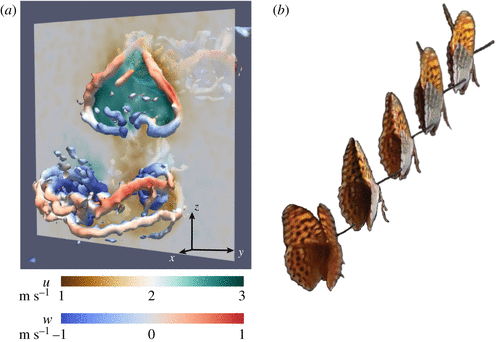
Becoming a Butterfly - Part 2: Butterfly Flight Mechanics
In the last post, we covered the creation of the monarch butterfly avatar that players will embody in this VR game/simulation. In this post, we’ll be discussing the development of our avatar’s flight capabilities, using the Nvidia PhysX engine in Unity. As a starting point, it’s important to first understand the basics of how real monarchs—and other butterflies—actually fly.
Butterfly Flight Mechanics, a very brief and simplified primer
Prior to researching this topic, our intuitive sense of how monarchs fly was simple: it’s all about the downstroke. That is, the lift (upward force) and propulsive thrust (forward force) that keep a butterfly suspended in the air and moving forward during standard flight are all generated by the butterfly moving its wings in a fast down- and maybe slightly backward motion, almost like a swimmer generating forward motion by pushing water away in the opposite direction.
This is not how it works. Downstrokes are important, yes, but upstrokes equally so. The basic picture is that like other butterflies, monarchs generate lift through the downstroke, but thrust is achieved primarily through the upstroke. The flexible wings of a butterfly are what make this possible, as they enable what is called the “clap and fling” mechanism. This is where the butterfly cups its wings together during an upstroke, collecting an air pocket between them, and then claps both wings together at the end of the upstroke, forcing the air pocket to shoot out behind the butterfly and thrusting it forward.

Butterfly Clap and Fling Mechanism. Image source: Johansson L. C. and Henningsson P. 2021, Figure 3; https://royalsocietypublishing.org/doi/10.1098/rsif.2020.0854
You can see these mechanics at work in the video below. Importantly, butterflies do not always use the clap and fling mechanism. For example, during takeoff a butterfly might perform a sequence of powerful downstrokes to generate enough lift to bring its body clear of the ground before using the clap and fling to begin moving forward. And, of course, the amount of force generated varies.
It’s also worth noting that there are many other factors at work here, including, the change in orientation of the butterfly’s body during upstrokes and downstrokes. Moreover, much of this is only true for forward, powered flight, as opposed to hovering, reverse flight, or gliding. I’ll touch on some of this below—particularly gliding, as it is absolutely crucial for migrating monarchs—but this simple forward flight model focused on variegated upstrokes and downstrokes is sufficient for our purposes here.
That’s all for this post.
Up next: implementing our flight model in Unity
Sources:
Agrawal, Anurag. Monarchs and Milkweed: A Migrating Butterfly, a Poisonous Plant, and Their Remarkable Story of Coevolution. Princeton University Press, 2017. JSTOR, www.jstor.org/stable/j.ctvc775wc. Accessed 29 Apr. 2021.
Dudley R, Srygley R. Flight Physiology Of Neotropical Butterflies: Allometry Of Airspeeds During Natural Free Flight. J Exp Biol. 1994 Jun;191(1):125-39. PMID: 9317473.
Dużmańska N, Strojny P, Strojny A. Can Simulator Sickness Be Avoided? A Review on Temporal Aspects of Simulator Sickness. Front Psychol. 2018;9:2132. Published 2018 Nov 6. doi:10.3389/fpsyg.2018.02132
Fei YH, Yang JT. Enhanced thrust and speed revealed in the forward flight of a butterfly with transient body translation. Phys Rev E Stat Nonlin Soft Matter Phys. 2015 Sep;92(3):033004. doi: 10.1103/PhysRevE.92.033004. Epub 2015 Sep 4. PMID: 26465553.
Gibo, David & Pallett, Megan. (2011). Soaring flight of monarch butterflies, Danaus plexippus (Lepidoptera: Danaidae), during the late summer migration in southern Ontario. Canadian Journal of Zoology. 57. 1393-1401. 10.1139/z79-180.
Johansson L. C. and Henningsson P. 2021 Butterflies fly using efficient propulsive clap mechanism owing to flexible wings J. R. Soc. Interface.182020085420200854 http://doi.org/10.1098/rsif.2020.0854
Monarch Watch : Reading Room : Frequently Asked Questions. https://www.monarchwatch.org/read/faq2.htm. Accessed 28 Apr. 2021.
Srygley, R., Thomas, A. Unconventional lift-generating mechanisms in free-flying butterflies. Nature 420, 660–664 (2002). https://doi.org/10.1038/nature01223
Yokoyama, Naoto & Senda, Kei & Iima, Makoto & Hirai, Norio. (2013). Aerodynamic forces and vortical structures in flapping butterfly’s forward flight. Physics of Fluids. 25. 021902. 10.1063/1.4790882.